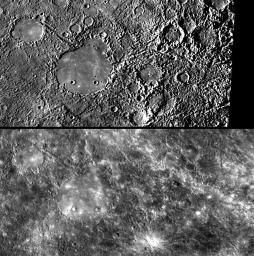The area on the opposite side of Mercury from the large Caloris impact basin (see PIA10359) is home to uncommonly bumpy and grooved terrain. Mariner 10 first observed the unusual surface textures at the Caloris antipodal region, and the Mariner 10 team informally dubbed it the "weird terrain." (Official geologic maps later adopted the more staid term "hilly and lineated terrain.") MESSENGER images from the mission's second Mercury flyby provide a second look at this "weird terrain" under substantially different lighting conditions. The top image is from Mariner 10, and the bottom image shows the same surface as seen by MESSENGER. The "weird terrain" is found mostly to the right of the large, smooth-floored crater in the images.
MESSENGER Science Team members are using the new views of the "weird terrain" to compare this region on Mercury with impact basin antipodes on the Moon. Basin antipodes on the Moon often contain unusual magnetized crust along with curving bright features called "lunar swirls." The different lighting condition of the MESSENGER images allowed a new search for swirl-like features near the Caloris antipode, but no obvious swirls have been found so far. Two years from now, imaging from orbit will provide a range of lighting conditions, enabling a more complete search for any swirl features. Additionally, once in orbit, MESSENGER's Magnetometer may be able to detect the presence of any magnetized crust in this region and other basin antipodes.
This new science result and the above images are being presented this week at the 40th Lunar and Planetary Science Conference. MESSENGER team members are making a total of 25 presentations at this annual meeting.
Date Acquired: October 6, 2008
Instrument: Narrow Angle Camera (NAC) of the Mercury Dual Imaging System (MDIS)
Resolution: 1 kilometer/pixel (0.6 miles/pixel)
Location: Images cover 327°-347°E, 25°-35°S
These images are from MESSENGER, a NASA Discovery mission to conduct the first orbital study of the innermost planet, Mercury. For information regarding the use of images, see the MESSENGER image use policy.

 Planetary Data System
Planetary Data System












